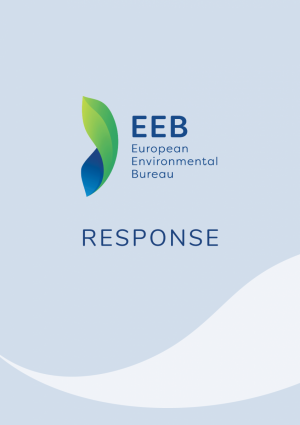
NGO comments to Wood and PFA report on polymer registration
We thank the consultancies Wood and PFA for the outstanding work performed to deliver their 2020 report for the European Commission titled “Scientific and technical support for the development of criteria to identify and group polymers for Registration/Evaluation under REACH and their impact assessment” (thereafter referred to as Wood&PFA report). This report documents scientific evidence, acknowledges remaining uncertainties, and outlines the assumptions and considerations involved in developing the criteria for the identification of polymers requiring registration (PRRs) under REACH. In their report, Wood and PFA state the following:
“Polymers are on the market in very high quantities, and very little is known about many of them, based on literature surveys conducted to date. The experience of REACH to date, in which much new information came out from the manufacturers’ own systems, could be repeated for PRRs, which would be a very significant gain for human and environmental protection.”
We strongly agree with this statement. The work on polymers registration under REACH is very important and cannot wait any longer. We emphasise that the ultimate measure for judging the appropriateness of the adopted polymer registration process and criteria should be not to provide for the least burden on industry but to ensure a high level of protection of human health and the environment. Therefore, while appreciating the consultancies’ work, we nonetheless would like to highlight several areas in the current report where we question some of the assumptions made, object exclusion or modification of some of the proposed criteria for PRR identification, suggest inclusion of additional criteria, and propose initiation of a mandatory pre-registration (initial notification) process to collect a defined minimal set of data for all polymers in the EU.
During the pre-registration phase, which should start as soon as possible, the European Chemicals Agency (ECHA) should receive a minimal set of data for all polymers manufactured or imported into the EU, i.e., including not only the suspected PRRs but also the presumed so-called “polymers of low concern” (PLCs) as well as everything “in-between.” After attending to only the strictly indispensable confidentiality claims, the submitted data should be immediately made publicly accessible to enable interrogation by authorities, academics and NGOs. The scope of submitted data should include all information necessary to make a decision on whether a polymer is a PRR. Since the industry will need to compile these data anyway in order to carry out their own assessments, only little additional costs can be expected to arise from transferring this information to ECHA, while the benefits to be gained are immense. First, these pre-registration data will provide the much-needed overview on the numbers, types, production volumes, applications, and characteristics of polymers in the EU. This will provide necessary oversight and ensure transparency, thus facilitating enforcement and strengthening public trust in polymer safety assessments. These data will also allow refining the cost-benefit analysis, currently limited by many uncertainties, and will facilitate further development of hazard assessment and grouping approaches, thus providing for more efficient and less costly full registration activities. A mandatory pre-registration requirement for all polymers goes in line with processes followed for non-polymeric substances and is in general long overdue in order to comply with the “no data no market” principle of REACH.
With regard to the underlying assumptions used when developing PRR registration criteria, we regret to see that the presented analysis does not address the issue of environmental pollution by macroplastics and secondary microplastics and nanoplastics generated from polymers during the production, use, and end-of-life phases. Both the persistence as well as propensity to generate micro/nanoplastics are inherent hazardous properties of many polymers. Taking into account the widespread exposure to micro/nanoplastics and continuously accumulating scientific evidence on the resulting adverse effects on human health and the environment, it becomes imperative that the proposed process for polymer registration under REACH properly addresses this issue by considering the persistence and micro/nanoplastics generation hazards within the risk assessment scheme and subsequent risk management goals. Consideration of environmental pollution issues also provides a strong support to including a PRR identification criterion focused on extremely high production volumes in association with widespread downstream uses prone to micro/nanoplastics generations and/or end-of-life mismanagement. Requirements for test data necessary to estimate exposures as well as to characterize hazards of secondary micro/nanoparticles should also be included as part of a full registration package where necessary.
We further object to reformulation or outright exclusion of some of the criteria for identification of PRRs as proposed in the Wood&PFA report, because in most cases none or very little scientific evidence has been presented as a justification for these wide-reaching decisions. This concerns, for example, the chosen focus on systemic bioavailability only, while disregarding the potential local effects and interactions with microbiota, and the resulting molecular weight (MW) cut-off thresholds; the unjustified increase in the % threshold for low molecular weight oligomer content; derogation for polymers that could become cationic or amphoteric in the environment; a lack of criteria for polymers with non-carbon backbones; the exclusion of criteria dealing with stability-preserving additives or impurities, although these form an inherent part of a polymer according to REACH definition; the unjustified exception for polyesters; and the exclusion of criteria addressing large production volumes, exposure potential, and degradability considerations. Substituting the now-excluded criteria by a vaguely formulated “safety net criterion” cannot be expected to provide sufficient level of protection of public health and the environment, therefore exclusion of those criteria is not justified and should be reconsidered.
The above-mentioned issues should form the basis for further discussion between the stakeholders. Below we provide a more detailed account of NGO position and arguments, presented as responses to the agenda items scheduled to be discussed during the 1st Meeting of REACH and CLP Competent Authorities Sub-Group on Polymers on September 11, 2020.






